
Tessa Pullan from Rutland, (born 1953) is an English sculptor. [1] [2]

Tessa Pullan from Rutland, (born 1953) is an English sculptor. [1] [2]


Pullan was from 1971 to 1974 in France apprenticed to the sculptor John Skeaping and then gained a diploma from 1974 to 1977 at the City and Guilds of London Art School. She studied from 1977 to 1980 from the Royal Academy of Arts in London. [3]
Her first exhibition took place in 1976 at London's Guildhall Art Gallery. In 1980 she started her first studio. The philanthropist and horse breeder Paul Mellon commissioned the Civil War Horse for the National Sporting Library and Museum in Middleburg, Virginia, [4] honouring the horses and mules who died during the American Civil War. [5] Her bust of Mellon is in the National Portrait Gallery. [6] She is now one of Britain's leading animal sculptors, working in a variety of media, but mainly bronze and wood. She also produces portraits. The artist has a studio in Barrowden, Rutland since 1990 and studios in Sandwich, Aberystwyth and Berkhamsted. [3]
She is a member of the Society of Equestrian Artists. [7]
The racehorse, Sea Hero, won the Kentucky Derby in 1993 and Pullan was tasked with creating a sculpture of him at the National Sporting Library and Museum. Created in bronze, the horse is over 7 ft and 2 tons in weight. [2]
The 1996 "Horse and Rider" galvanised steel statue on the Black Country Route, Wolverhampton was commissioned by Wolverhampton City Council. Pullan carved the sculpture using wood and then the model was scaled up and produced in steel by Arden Fabrications of Knowle. [8] [9]
Pullan was given instructions by Paul Mellon to make a bronze, three-quarter size statue of a Civil War Horse. [10] As part of her research, she contacted the Society for the Prevention of Cruelty to Animals for images of abused horses to influence the oppressive appearance of the statue. [1] On 17 September 1997, the statue was unveiled by the Virginia Historical Society. [11]

Sir William Hamo Thornycroft was an English sculptor, responsible for some of London's best-known statues, including the statue of Oliver Cromwell outside the Palace of Westminster. He was a keen student of classical sculpture and was one of the youngest artists to be elected to the Royal Academy, in 1882, the same year the bronze cast of Teucer was purchased for the British nation under the auspices of the Chantrey Bequest.
An equestrian statue is a statue of a rider mounted on a horse, from the Latin eques, meaning 'knight', deriving from equus, meaning 'horse'. A statue of a riderless horse is strictly an equine statue. A full-sized equestrian statue is a difficult and expensive object for any culture to produce, and figures have typically been portraits of rulers or, in the Renaissance and more recently, military commanders.

Edward Clark Potter was an American sculptor best known for his equestrian and animal statues. His most famous works are the marble lions, nicknamed Patience and Fortitude, in front of the New York Public Library Main Branch
Herbert Chevalier Haseltine (1877–1962) was an Italian-born French/American animalier sculptor, most known as an Equestrian sculptor.

Clark Mills was an American sculptor, best known for four versions of an equestrian statue of Andrew Jackson, located in Washington, D.C., with replicas in Nashville, Tennessee, Jacksonville, Florida, and New Orleans, Louisiana.
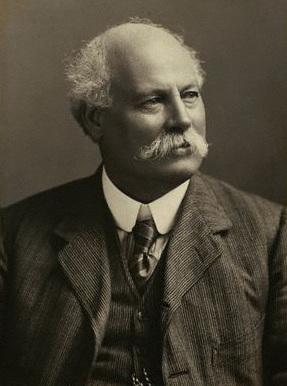
Sir Thomas Brock was an English sculptor and medallist, notable for the creation of several large public sculptures and monuments in Britain and abroad in the late nineteenth and early twentieth centuries. His most famous work is the Victoria Memorial in front of Buckingham Palace, London. Other commissions included the redesign of the effigy of Queen Victoria on British coinage, the massive bronze equestrian statue of Edward, the Black Prince, in City Square, Leeds and the completion of the statue of Prince Albert on the Albert Memorial.
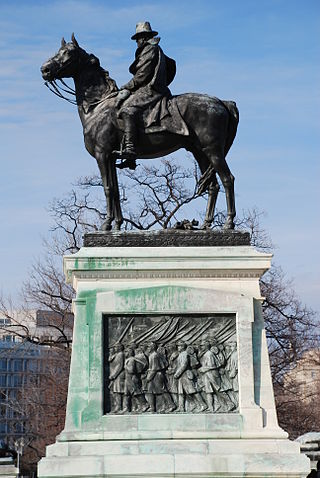
The Ulysses S. Grant Memorial is a presidential memorial in Washington, D.C., honoring American Civil War general and 18th United States President Ulysses S. Grant. It sits at the base of Capitol Hill, below the west front of the United States Capitol. Its central sculpture of Grant on horseback faces west, overlooking the Capitol Reflecting Pool and facing toward the Lincoln Memorial, which honors Grant's wartime president, Abraham Lincoln. Grant's statue is raised on a pedestal decorated with bronze reliefs of the infantry; flanking pedestals hold statues of protective lions and bronze representations of the Union cavalry and artillery. The whole is connected with marble covered platforms, balustrades, and stairs. The Grant and Lincoln memorials define the eastern and western ends, respectively, of the National Mall.

Alfred Adrian Jones was an English sculptor and painter who specialized in depicting animals, particularly horses. Before becoming a full-time artist he was an army veterinary surgeon for twenty-three years. On retirement from the Army, Jones established himself as an artist with a studio in London. He became a regular exhibitor at the Royal Academy and in commercial galleries from 1884 onwards. His training as a veterinary surgeon gave him a deep knowledge of equine anatomy which he used in his work to great effect. He created the sculpture Peace descending on the Quadriga of War, on top of the Wellington Arch at Hyde Park Corner in London. Following both the Boer War and World War I, Jones created a number of notable war memorials including the Royal Marines Memorial and the Cavalry of the Empire Memorial, both in central London. Alongside the public monuments he created, Jones made equestrian and equine statuettes and portrait busts. Whilst well known as a sculptor, Jones was also an accomplished painter.

Anna Vaughn Hyatt Huntington was an American sculptor who was among New York City's most prominent sculptors in the early 20th century. At a time when very few women were successful artists, she had a thriving career. Hyatt Huntington exhibited often, traveled widely, received critical acclaim at home and abroad, and won multiple awards and commissions.

The National Sporting Library & Museum or NSLM is a research library and art museum in Middleburg, Virginia in the United States.

Thomas Thornycroft was an English sculptor and engineer.
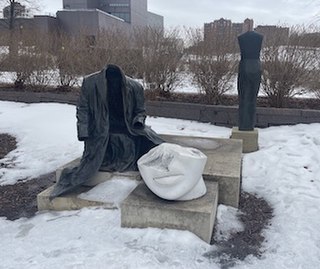
Judith Shea is an American sculptor and artist, born in Philadelphia, Pennsylvania, in 1948. She received a degree in fashion design at Parsons School of Design in 1969 and a BFA in 1975. This dual education formed the basis for her figure based works. Her career has three distinct phases: The use of cloth and clothing forms from 1974 to 1981; Hollow cast metal clothing-figure forms from 1982 until 1991; and carved full-figure statues made of wood, cloth, clay, foam and hair beginning in 1990 to present.
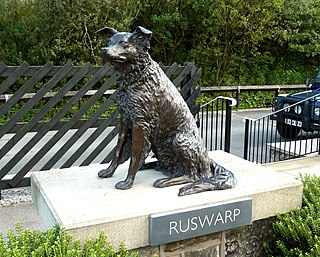
Joel (Jo) Walker, also known as JOEL or Sculptress JOEL is an English sculptor, known for depicting animals.

Brenda Putnam was an American sculptor, teacher and author.

The Victorious Charge is a public artwork by American artist John S. Conway located on the Court of Honor on West Wisconsin Avenue in downtown Milwaukee, Wisconsin, United States. The 1898 bronze sculpture is 9'10" high and sits on a 20' square granite pedestal.

General Philip Sheridan is a bronze sculpture that honors Civil War general Philip Sheridan. The monument was sculpted by Gutzon Borglum, best known for his design of Mount Rushmore. Dedicated in 1908, dignitaries in attendance at the unveiling ceremony included President Theodore Roosevelt, members of the President's cabinet, high-ranking military officers and veterans from the Civil War and Spanish–American War. The equestrian statue is located in the center of Sheridan Circle in the Sheridan-Kalorama neighborhood of Washington, D.C. The bronze statue, surrounded by a plaza and park, is one of eighteen Civil War monuments in Washington, D.C., which were collectively listed on the National Register of Historic Places in 1978. The sculpture and surrounding park are owned and maintained by the National Park Service, a federal agency of the Interior Department.
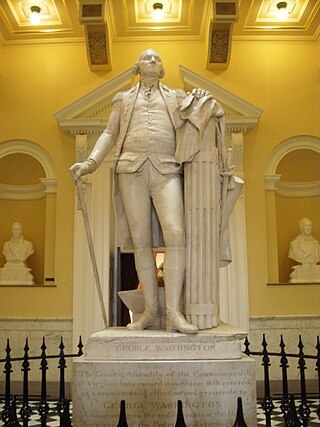
George Washington is a statue by the French sculptor Jean-Antoine Houdon from the late 18th century. Based on a life mask and other measurements of George Washington taken by Houdon, it is considered one of the most accurate depictions of the subject. The original sculpture is located in the rotunda of the Virginia State Capitol in Richmond, Virginia, and it has been copied extensively, with one copy standing in the United States Capitol Rotunda.

Major General George Henry Thomas, also known as the Thomas Circle Monument, is an equestrian sculpture in Washington, D.C. that honors Civil War general George Henry Thomas. The monument is located in the center of Thomas Circle, on the border of the downtown and Logan Circle neighborhoods. It was sculpted by John Quincy Adams Ward, best known for his work on the statue of George Washington in Wall Street, Manhattan. Attendees at the dedication in 1879 included President Rutherford B. Hayes, Generals Irvin McDowell, Philip Sheridan, and William Tecumseh Sherman, senators and thousands of soldiers.

Brevet Lt. General Winfield Scott is an equestrian statue in Washington, D.C., that honors career military officer Winfield Scott. The monument stands in the center of Scott Circle, a traffic circle and small park at the convergence of 16th Street, Massachusetts Avenue and Rhode Island Avenue NW. The statue was sculpted by Henry Kirke Brown, whose best-known works include statues of George Washington in New York and Nathanael Greene in Washington, D.C. It was the first of many sculptures honoring Civil War generals that were installed in Washington, D.C.'s traffic circles and squares and was the second statue in the city to honor Scott.
{{cite book}}: CS1 maint: location (link)